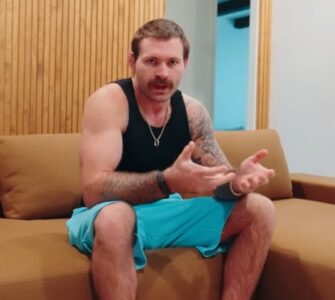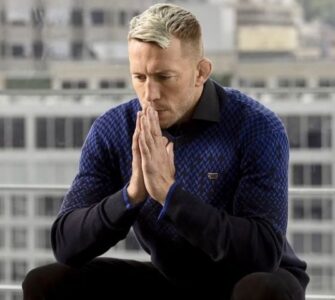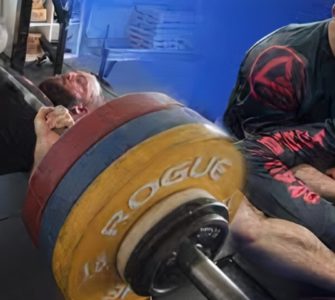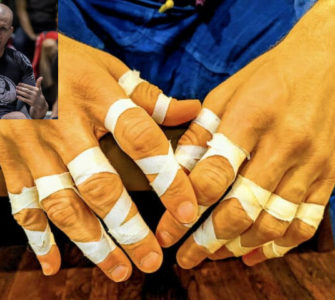Guest post by Sam Yang. He is a brown belt under Rubens “Cobrinha” Charles Maciel and writes about martial arts and philosophy at MustTriumph.com
Physical exertion was and still is the first form of character building. As children, movement was the initial way we learned to assert ourselves. For our parents, our physical behavior was the only window into our character. And initially, the only way for our parents to influence our character was to influence our movements: explore, play, run, touch this, and don’t touch that. We call this childhood.
“Difficulties strengthen the mind, as labor does the body.” — Seneca
Physical culture, and eventually exercise, became a tangible and easily understood way to modify ourselves. Prior to all the industrial and technological revolutions, we didn’t dissociate ourselves from our bodies. They were one and the same, and changing our body also meant changing our being. When life was based mostly on physical labor, more strength could completely alter one’s life.
Fitness used to be an indication of your character. Your body was the physical manifestation of the life you lived, your work ethic, and your resilience. Calloused hands, strong neck, and strong arms meant you engaged in honest, hard work. These were the symbols of your virtue, the strength of the commoner, symbolic of your ability to overcome obstacles. Today it’s a metaphor, yesterday it was a truth of life—moving and molding the earth with your bare hands.
Greek athletes and Roman gladiators personified the power of their nations. Myths and fables honored the hero who could overcome all odds. Within their chiseled bodies was an even greater spirit that was beyond measure. The body was just a canvas where some of their greatness bled. Sometimes the gods bestowed powers and gifts to those who were worthy, those who already exemplified effort and grit. Calisthenics, in many ways the first form of exercise, comes from the ancient Greek words kállos and sthénos, meaning “beauty” in “strength.” We are just now reawakening this old idea of beautiful strength—that strength is beautiful and beauty should not avoid strength but embrace it.
“No one has the right to be an amateur in the matter of physical training. It is a shame for anyone to grow old without seeing the beauty and strength of which their body is capable.” — Socrates
Your Body Is the Temple You Spend Your Whole Life Cultivating
Though it seems odd now, in the ancient world, the social elites were physical. They bent and stretched, symbolic of their flexible minds that could work out problems. They also ran and engaged in activities that involved taxing their lungs. Instead of working their muscles, it was about working their heart. This wouldn’t create the body of a laborer. It was more internal, it was about having an indomitable will. Endurance activities were about a person’s ability to endure. That is the quality worth cultivating. A marathon is not an effective way to attain health but it is a tremendous symbol of one’s spirit, mindset, and fortitude. How we exercise is another way to say, this is who I am.
Push-Ups First, Philosophy Second
Socrates, followed by his disciple Plato, trained their students in physical culture. (All the Greek and Roman philosophers involved themselves in physical culture. It was as mandatory then as learning how to read is today.) Only recently did we divorce virtues and the good life from the physical life—a product of industrialization and dualism.
Calisthenics, running, and wrestling, were taught alongside mathematics and astronomy. The belief was, to sharpen the mind, one must first sharpen the body—for the body is material and easier to mold. It is also the way we experience life, through our senses, and without experience, philosophy is impossible to teach. (Everything would be abstract and unknowable.) Evolution and the increasing of intelligence are biological (physical) processes.
“Mens sana in corpore sano”—Latin for a healthy body is a healthy mind or a healthy mind is a healthy body.
If one were really intellectual, the value of the physical would be self-evident. If one were really physical, one would be empirically aware. This gap in coherence is called cognitive dissonance, otherwise known as contradicting yourself. The body and mind exist so that we may experience life. One without the other is sense without knowledge, and knowledge without sense.
Fight, wrestle, run, because without it, you are too stupid and lazy to teach. This was the blunt lifesaving wisdom of the time. The intellectual were physical; the physical were intellectual. One should neither be a novice in either. Today we believe the opposite, the intellectual and physical at odds—without a sense of a unified culture. Though the Atlantic and Pacific are different oceans, they are still the same body of water. That is how we saw the mind and the body, connected and balanced, one body of water. Then came a major intellectual change: dualism. Rather than connected and seeking harmony, all things became disconnected and existing to oppose one another. No balance, only one or the other, us vs. them, this vs. that. And we are that much further from the good life—individually and as a people.
Hard-work is a virtue. Now we think of traits relative to the specific activity, not to the individual. I work hard at the gym or I work hard at school. The emphasis on the activity not on the person. Not: I am a hard worker. Period.
Virtue cannot be dissected by capitalist specifications. The goal is to improve the individual—his or her character and virtue, not the productivity of the activity. The activity is the tool for the individual, but now we have misguidedly reversed it, and we see ourselves as tools for the activity. We have become the hammer, not the craftsman who wields the hammer.
And if we are all tools, then it makes sense humans must compete with calculators for wages. Tools can replace our thinking; tools can replace our physicality, because we have come to believe we can’t both think and be physical. It’s a binary, one or the other. The nerd and the jock have become two different classifications when it used to be one individual. A complex being separated into two simple caricatures. And this is why we have lost our intrinsic value. Divided, our soul is much easier to conquer.
Rather than contemplation, modern physical culture encourages us to shut off our minds, self-indulge, replace happiness with hedonist pleasure, be oblivious, be productive, and spend, spend, spend. Vanity has become a virtue rather than a vice. Self-indulgence is no longer frowned up, but deeply encouraged. For all this increases consumption. For all this makes us better employees and better consumers.
Rather than being different aspects of the same culture, intellectual culture now exists to oppose physical culture, it exists to think and worry, but still produce, and still consume. All in the name of the cash economy. We can code-switch from one to the other, an intelligent machine at work, a stupid athlete at the gym, rather than marrying the two: an intelligent-athlete at work and at the gym. It is a time of divorce, everything that was once whole, is now divided. Are we individuals or are we consumers? The cash economy can easily replace simple stereotypes, but complex beings who can exist in the middle are harder to control and irreplaceable.
We Have Separated the Mind From the Body and Spirit
We have disembodied ourselves from our bodies. We no longer use exercise to build ourselves up, we are looking for ways to use exercise to only build up our bodies. We have reduced and isolated: machines, molecules, cells, and even ourselves. Reducing our being to only the mind. The mind has become the thing of value in a post-industrial world, just a hard drive. (But that, too, is changing, as machines are doing it better.) Our bodies the vehicle, its sole purpose is to get our minds to work and back. For many, as long as it functions, it’s good enough, leading to mistreatment. Like having a nice car, the body has become about status. It’s still something separate from the being, but like any accessory, we care about how it looks. People often use the car analogy to describe why they should take care of their bodies. This analogy, itself, says that disembodying our bodies from ourselves makes sense. It’s the wrong way to value our bodies. It is not a car, it is us. Our mind is not a computer, it is us. When we refuse to reflect on our own beliefs is when we uncouple our minds from our consciousness.
It’s normal to associate exercise with isolation; isolate not only the body from the mind, but certain body parts from the rest of the body. We reduce our very being and worth to a specific portion of our abdomen. Above our hip bone and below the rib cage. We have been reduced to a 4-inch block of tissue known as “the love handle.” Rather than just a mind, we can run to the opposite extreme, reducing ourselves to a piece of flesh. Rather than treating the body, we create diseases of the mind.
Where is the room for the spirit? Where is there fertile soil to grow character? What was once the only reason to exercise, has decayed into an abstract thought: What does exercise have to do with character building? What does my mind have to do with what my body does? What does any of this have to do with looking good with my shirt off? I take my clothes to the dry cleaners and they take care of it. I take my body to the gym, to my trainer, throw it in there and zone out, and they take care of the rest and return it back to me at the allotted time. Without the spirit, we develop a mechanized mind, Einstellung effect, and lose our conscious mind. The opposite of mindfulness, but rather, mindlessness. Just unthinking machines, a calculator or a dump truck.
Proper physical work, like any intense labor, requires concentration and coordination. Yet many slave away at the gym for years, with no increase in coordination or concentration. Toiling like mindless drones. What did we spend all of our time doing? So we stop. We replaced meaning with motivation. Motivation, like the drummer who keeps the beat for the slaves to row. Physical movement, something we should take joy in, do of our own volition, most of us do because we think we have to, and we look for ways to trick our minds to make ourselves do it. That is our societal sickness and we as a modern culture believe this is normal. It’s normal to sit in a sauna to try and lose weight but complain that it’s hot when we exercise. We complain when we have to walk far from our cars to the gym, when the point of the gym is to move more. And this, too, is normal.
In speaking of mindfulness, it is a term thrown around in modern wellness, along with holistic. Mindfulness used to mean being aware of one’s self, one’s thoughts and actions. Now it’s more like being like a docile cow, oblivious to the world, as long as you can graze on goods. Holistic used to be the opposite of extremism, characterized by the comprehension of the parts of something as intimately interconnected and explicable only by reference to the whole. Now it’s used to mean extremely alternative or against convention. Holistic used to be interchangeable with totality, an umbrella, but now it means specificity (these specific things but not those other things). This growing extremism of dividing ourselves, individually and as groups, only lead to more tension and unease: elitist thinkers vs. salt of earth workers, left vs. right, up vs. down. Separating so we can create new adversaries, to further dualism. In the contemporary world of competition, we always need adversaries. We actually believe that is our purpose, to unhappily compete, rather than the old idea of satisfaction and the good life. But whatever happened to simply blooming?
It was once difficult to think of our mind, body, and spirit as separate entities. Now it’s difficult to think of them as being the same. We abandon spirit, the soul of character, and we pretend the body is an alien with which we have a symbiotic relationship. We have gone backwards in thinking. This can only lead to unhappiness, poor self-image, lack of body acceptance, and superficiality. Bad movies have one-dimensional characters, flat and wooden. If we are just our bodies or we are just our minds, we are no different from a stock character, incomplete, yet to be fleshed out. We compliment people on their appearance, especially women. How often do we compliment women based on their character and ability? Our sense of worth has become so distorted that “you look great” has become a better compliment than “great job.” We hate stereotypes but we keep living up to them.
Maybe Your Mind Doesn’t Understand but Your Body and Spirit Does
With all that said, we still value character over the body. We may not consciously understand it, but internally it’s as vital as breath. The people who consistently exercise, the secret is in how they view exercise. They talk about it as transformative, beyond just the physical. It’s not something they check off of a to-do list, it’s an experience. It’s crucial to them, to their being, because it is meaningful—which is why they keep doing it. They don’t want to turn their minds off, they want to be present in the experience. Because that’s the point. They have adopted physical culture and whether they realize it or not, they have aligned fitness with character, and this is why it works. This is the popularity of sports, it satisfies something we can’t get from books. Experience.
Remove the Meaning From Exercise and It Is Meaningless
When we make it only about the body, it doesn’t “click.” People in it purely for the physical pursuit; even if their pursuit is “health” driven, struggle with lasting change. Ignoring holistic health for specific “health” is not meaningful enough. If you are shallow, then exercise for appearance becomes an obsessive act—that is the character you’re building. Sacrificing mental health for the physical, which only hurts the physical. Just as the intellectual sacrifices physical for the mental, which only hurts the mental. And overall health, longevity, and life experience pay the price.
We must integrate exercise as a part of our values, instead of making it a challenger to our values. If it’s working out or playing with our children, children should win. If we see exercise as something that not only enhances our ability to play with our children but also makes us a better parent, then we will find ways to do both. Both will improve. When we reduce our nature down to parts and isolate it, we make it a “this vs. that” proposition. If we consider it like a diamond; different facets of the same being, rather than “this vs. that” it becomes “this and that,” this improves that, this is a part of that. Then physical capacity becomes a part of improving overall capacity.
Summary
Trying to change exercise to fit “you” is why many fail. Rather than being egocentric, allow exercise to change you. We didn’t need exercise in the past, our lives were physical enough. And if not, we pursued a more physical one. Exercise becomes an extension of living a more robust life, but so does hiking, climbing, moving, running, swimming, mountaineering, and playing. Exercise is preparatory training for living the life we want to live. To experience without physical limitations. Yet that kind of life feeds our bodies, and proportions our character to match our bodies: strong, fast, flexible, and consistent.
















